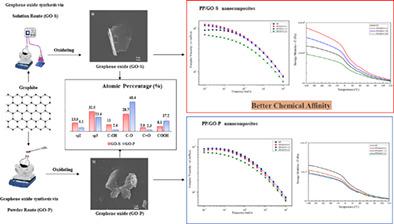当前位置:
X-MOL 学术
›
Polym. Compos.
›
论文详情
Our official English website, www.x-mol.net, welcomes your
feedback! (Note: you will need to create a separate account there.)
Tailoring the graphene oxide chemical structure and morphology as a key to polypropylene nanocomposite performance
Polymer Composites ( IF 4.8 ) Pub Date : 2021-09-07 , DOI: 10.1002/pc.26297 Pamela S. Garcia 1 , Yuri D. C. Oliveira 1 , Fernanda C. F. Valim 1 , Rumiana Kotsilkova 2 , Evgeni Ivanov 2, 3 , Ricardo K. Donato 4 , Guilhermino J. M. Fechine 1 , Ricardo J. E. Andrade 1
Polymer Composites ( IF 4.8 ) Pub Date : 2021-09-07 , DOI: 10.1002/pc.26297 Pamela S. Garcia 1 , Yuri D. C. Oliveira 1 , Fernanda C. F. Valim 1 , Rumiana Kotsilkova 2 , Evgeni Ivanov 2, 3 , Ricardo K. Donato 4 , Guilhermino J. M. Fechine 1 , Ricardo J. E. Andrade 1
Affiliation

|
In this work, we designed and studied two synthetic routes, based on modified Hummers method, to obtain graphene oxide (GO), and investigated their influence on the performance of polypropylene (PP)/GO nanocomposites. The two synthetic routes differed in the application condition of the oxidizing agent, potassium permanganate (KMnO4), which was added either as a powder (GO-P) or as a water solution (GO-S). This apparently subtle synthetic change yielded GOs with different degrees of oxidation and particle sizes, where GO-P presented a higher oxidation degree and smaller particles. The different GOs were then melt-blended with PP and the correlation between their different chemical/morphological structures and the nanocomposites' thermomechanical/rheological properties were evaluated. The milder oxidation process suffered by GO-S, and consequent less hydrophilic character, yielded a PP/GO-S nanocomposite with improved performance as the consequence of a better matrix/filler chemical affinity, mainly in compositions with lower GO-S contents. The thermal stability was increased by more than 10°C when 0.1 wt% GO-S was inserted into PP. When compared to the composition with 0.1 wt% GO-P, the increase was 13°C. Reinforcing effects were also observed in that sample (with 0.1 wt% GO-S), which exhibited the highest storage modulus and complex viscosity. These results suggest that tailoring the GO's oxidation degree and morphology is a key point to obtain an ideal interfacial interaction between phases.
中文翻译:

调整氧化石墨烯的化学结构和形态是聚丙烯纳米复合材料性能的关键
在这项工作中,我们基于改进的 Hummers 方法设计并研究了两条合成路线,以获得氧化石墨烯 (GO),并研究了它们对聚丙烯 (PP)/GO 纳米复合材料性能的影响。两种合成路线在氧化剂高锰酸钾(KMnO 4),以粉末 (GO-P) 或水溶液 (GO-S) 的形式加入。这种明显微妙的合成变化产生了具有不同氧化程度和粒径的 GO,其中 GO-P 呈现更高的氧化程度和更小的颗粒。然后将不同的 GO 与 PP 熔融共混,并评估其不同化学/形态结构与纳米复合材料的热机械/流变性能之间的相关性。GO-S 的氧化过程较温和,因此亲水性较低,产生了具有更好性能的 PP/GO-S 纳米复合材料,这是由于更好的基质/填料化学亲和力,主要是在 GO-S 含量较低的组合物中。当 0.1 wt% GO-S 插入到 PP 中时,热稳定性提高了 10°C 以上。与 0 的组合相比。1 wt% GO-P,增加了 13°C。在该样品(含有 0.1 wt% GO-S)中也观察到了增强效应,其表现出最高的储能模量和复数粘度。这些结果表明,调整 GO 的氧化程度和形貌是获得理想的相间界面相互作用的关键。
更新日期:2021-11-09
中文翻译:

调整氧化石墨烯的化学结构和形态是聚丙烯纳米复合材料性能的关键
在这项工作中,我们基于改进的 Hummers 方法设计并研究了两条合成路线,以获得氧化石墨烯 (GO),并研究了它们对聚丙烯 (PP)/GO 纳米复合材料性能的影响。两种合成路线在氧化剂高锰酸钾(KMnO 4),以粉末 (GO-P) 或水溶液 (GO-S) 的形式加入。这种明显微妙的合成变化产生了具有不同氧化程度和粒径的 GO,其中 GO-P 呈现更高的氧化程度和更小的颗粒。然后将不同的 GO 与 PP 熔融共混,并评估其不同化学/形态结构与纳米复合材料的热机械/流变性能之间的相关性。GO-S 的氧化过程较温和,因此亲水性较低,产生了具有更好性能的 PP/GO-S 纳米复合材料,这是由于更好的基质/填料化学亲和力,主要是在 GO-S 含量较低的组合物中。当 0.1 wt% GO-S 插入到 PP 中时,热稳定性提高了 10°C 以上。与 0 的组合相比。1 wt% GO-P,增加了 13°C。在该样品(含有 0.1 wt% GO-S)中也观察到了增强效应,其表现出最高的储能模量和复数粘度。这些结果表明,调整 GO 的氧化程度和形貌是获得理想的相间界面相互作用的关键。











































 京公网安备 11010802027423号
京公网安备 11010802027423号